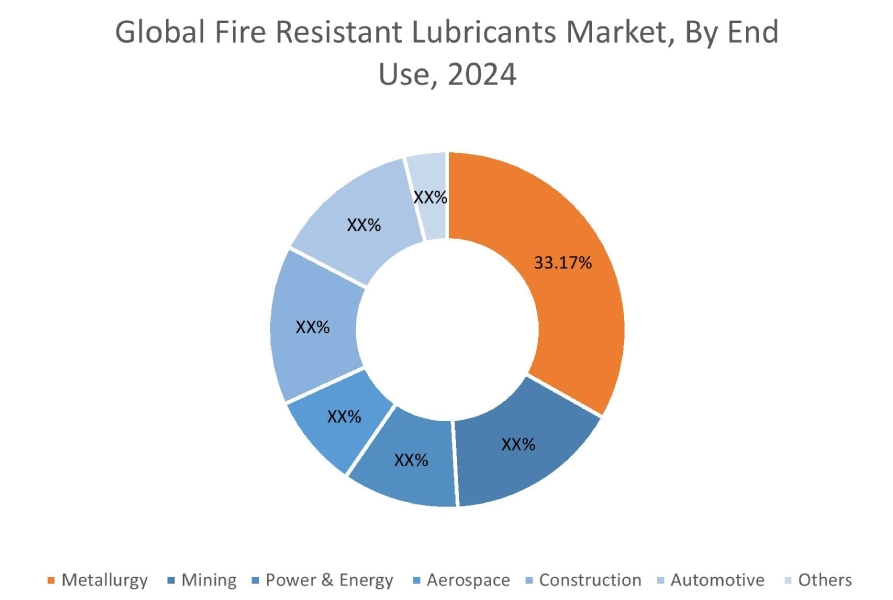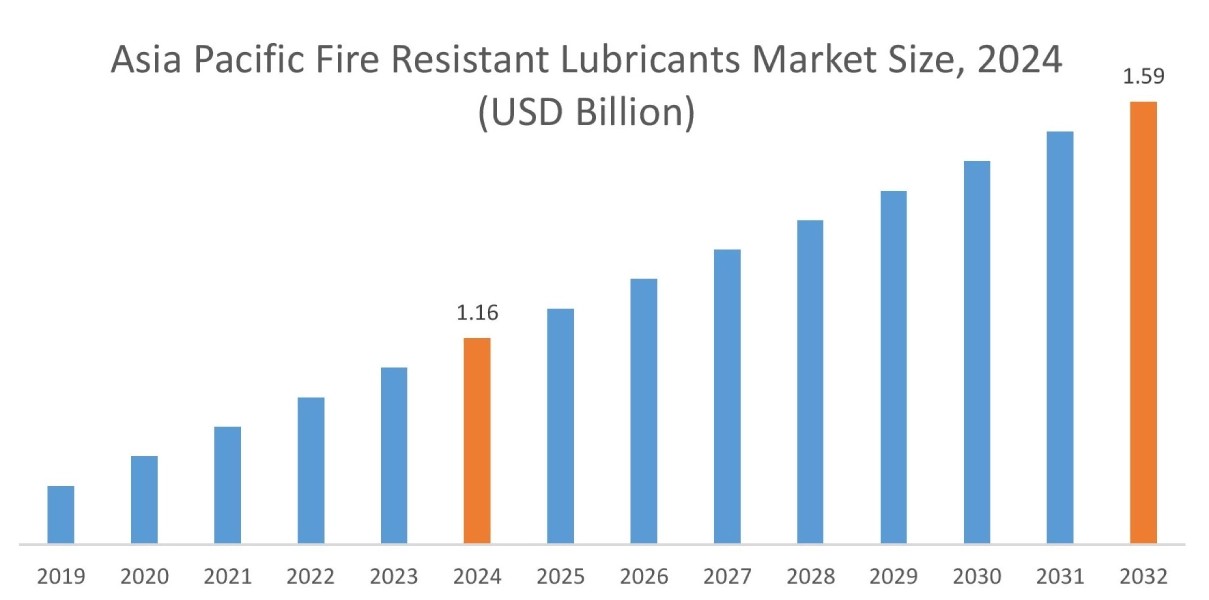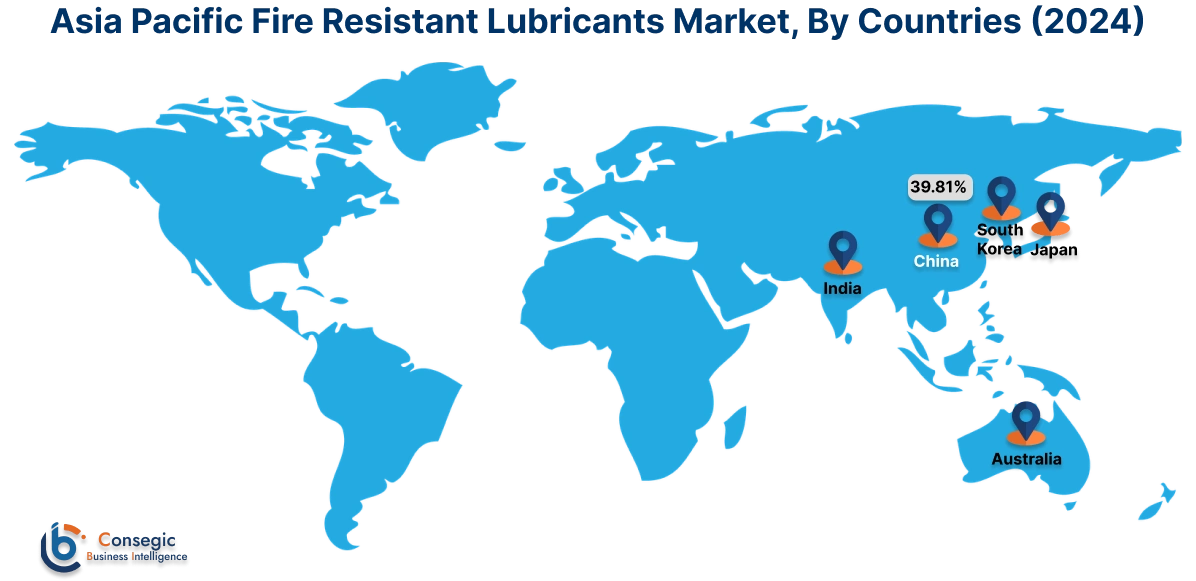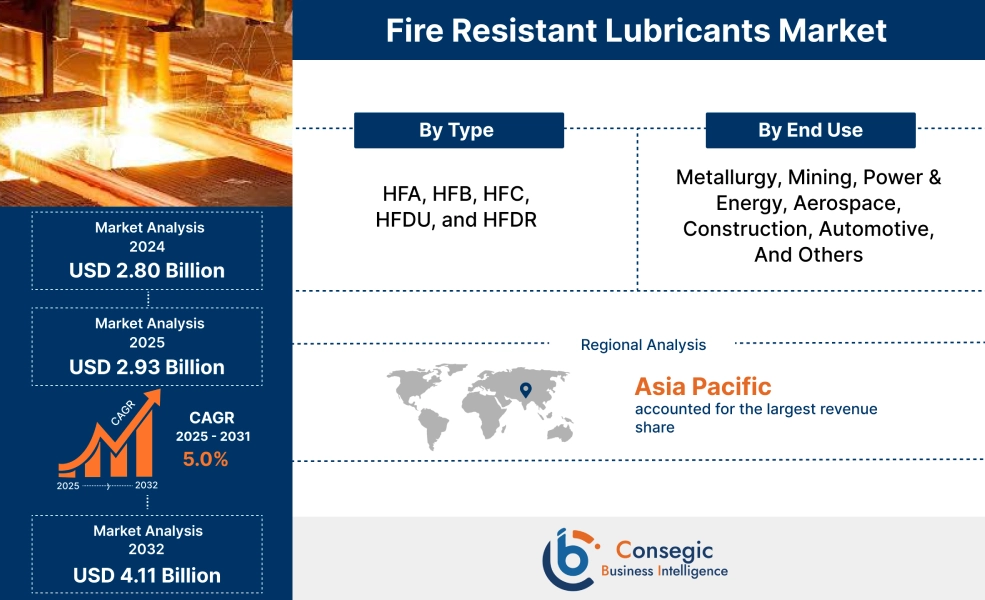Fire Resistant Lubricants Market Size:
The Fire Resistant Lubricants market size is growing with a CAGR of 5.0% during the forecast period (2025-2032), and the market is projected to be valued at USD 4.11 Billion by 2032 from USD 2.80 Billion in 2024. Additionally, the market value for 2025 is attributed to USD 2.93 Billion.
Fire Resistant Lubricants Market Scope & Overview:
Fire resistant lubricants are specialized fluids engineered to significantly reduce the risk of ignition and fire propagation in industrial applications where conventional lubricants pose a considerable hazard. These lubricants are designed to maintain their integrity and provide essential lubrication, wear protection, and corrosion control even when exposed to high temperatures, open flames, or other ignition sources. Their formulations, which often include water-based solutions and synthetic esters, are characterized by high flash points and auto-ignition temperatures, along with properties that actively suppress combustion. The adoption of fire-resistant lubricants is crucial for enhancing operational safety, protecting valuable equipment, and ensuring compliance with stringent safety regulations across high-risk sectors such as metal processing, mining, power generation, and aerospace among others.
Fire Resistant Lubricants Market Dynamics - (DRO) :
Key Drivers:
Strict Safety Regulations and Compliance to Drive Fire Resistant Lubricants Market Growth.
Sectors operating in high-risk environments, such as metal processing, mining, power generation, and aerospace, are compelled to adhere to strict safety standards set by governmental bodies. Regulations set by organizations such as OSHA (Occupational Safety and Health Administration) and NFPA (National Fire Protection Association), among others often mandate the use of lubricants that are capable of withstanding extreme temperatures and resist ignition, minimizing the potential for catastrophic fires and explosions. As a result, businesses are testing lubricants with fire resistance to mitigate operational risks, ensure worker safety, and meet legal obligations, thereby consistently boosting need for these specialized fluids.
- For instance, In the second quarter of 2024, Enhim LLC, supplied 86,480 kg of fire-resistant turbine oil to several power plants belonging to the Inter RAO Group.
Hence, this regulatory push establishes a consistent and expanding market for manufacturers, making it a crucial driver for fire resistant lubricants market growth on a global scale.
Key Restraints:
Complex Maintenance and Compatibility Issues to Hinder Fire Resistant Lubricants Market Expansion.
The fire-resistant lubricants market demand faces constraints due to the complex maintenance and compatibility issues. Unlike conventional mineral oils, many fire-resistant formulations, particularly certain synthetics or water-based types, demand specialized handling, storage, and stringent monitoring protocols, such as regular water content analysis for HFC fluids. Furthermore, their unique chemical compositions result in incompatibility with existing system components like seals, hoses, paints, or other residual fluids. This necessitates costly system overhauls or specific material selection during implementation, increasing the total cost of ownership. Such complexities and potential disruptions to operations often make end-users hesitant to transition from traditional lubricants. As a result, the above-mentioned factors are limiting the fire-resistant lubricants market expansion.
Future Opportunities :
Growing Demand for Environmentally Friendly Solutions to Accelerate to Create Market Opportunities.
As global awareness concerning environmental impact and worker health rises, sectors are increasingly pressured by stricter regulations and consumer preferences to adopt more sustainable practices. This shift is driving innovation and investment in the development of bio-based and less toxic lubricants with fire resistance. Manufacturers are focusing on formulations, such as certain VOC free lubricants that offer comparable or superior performance to traditional options while minimizing their ecological footprint and enhancing safety. This alignment with corporate sustainability goals and the push to reduce reliance on petroleum-based products creates a lucrative niche.
- For instance, in 2025, TotalEnergies Lubricants expanded its sustainable product portfolio by acquiring fluid competence's corsave (water-based, HFA-group) and Lubsave (water-glycol-based, HFC-E-group) fire-resistant hydraulic fluid lines, enhancing its offerings for safety-critical applications in sectors like steel, mining, and tunneling.
Thus, these green alternatives are opening new avenues for product development and market penetration for companies committed to environmental responsibility, thereby supporting market revenue in forecast years.
Fire Resistant Lubricants Market Segmental Analysis :
By Type:
Based on type, the market is categorized into HFA, HFB, HFC, HFDU, and HFDR.
Trends in Type:
- Increasing adoption of HDFU in sectors including metalworking, mining, and power generation due to stringent safety regulations and need for reliable, long-lasting, and environmentally friendly solutions is a key trend.
- Ongoing advancements in formulation to improve corrosion resistance, compatibility with newer hydraulic systems, and better environmental profiles.
The HFC segment accounted for the largest market share in 2024.
- HFC fluids are solutions of water and glycols such as ethylene or propylene glycol, containing approximately 35-50% water.
- Their high-water content provides excellent non-flammability and thermal stability, making them highly suitable for critical applications in high-risk sectors such as steel production, metal processing, mining, and power generation where ignition sources and high temperatures are prevalent.
- Additionally, HFC fluids offer good lubrication properties, corrosion protection, and favorable industrial acceptability. Their relatively lower cost compared to other synthetic fire-resistant alternatives, coupled with compliance with stringent safety regulations, further drives their widespread adoption.
- Thus, as per the fire resistant lubricants market analysis, the HFC segment is dominating the fire resistant lubricants market demand.
The HFDU segment is expected to grow at the fastest CAGR over the forecast period.
- Lubricants of HFDU type are fully synthetic, water-free fluids primarily based on polyol esters.
- HFDU fluids offer excellent fire resistance, superior lubrication properties, high thermal stability, and good viscosity stability over a wide temperature range and are widely used in casting, diecasting, forming, forging, and power generation.
- They are biodegradable and considered environmentally friendly, making them a preferred choice for high-performance and environmentally sensitive applications.
- For instance, BioBlend, expanded its product line with BioFlo Synthetic HFDU, a new synthetic, fire-resistant hydraulic oil that offers a safe, high-performance, and environmentally responsible alternative to mineral oil, and is Factory Mutual approved.
- Hence, as per the analysis, HFDU is projected to experience the fastest growth.
By End Use:
Based on end use, the market is categorized into metallurgy, mining, power & energy, aerospace, construction, automotive, and others.
Trends in the End Use:
- A rising trend is the increased focus on biodegradable and environmentally friendly fire-resistant lubricants for mining operations to reduce ecological impact.
- Emerging necessity for specialized fire-resistant lubricants in certain electric vehicle (EV) components and battery manufacturing for enhanced safety is a key trend.
The metallurgy segment accounted for the largest fire resistant lubricants market share of 33.17% in 2024.
- The metallurgy sector is a significant consumer of fire-resistant lubricants, given the inherent fire hazards in metal forging, cutting, and other high-temperature processes.
- The sector's present high-risk environment involving molten metals, extreme temperatures, and heavy machinery, which necessitate superior fire safety.
- Lubricants with fire resistance are critically employed in hydraulic systems, furnace controls, and various rolling mill applications to prevent ignition and ensure operational continuity and safety.
- The continuous need for metals including steel and aluminum for infrastructure, automotive among others, support the segment growth.
- For instance, according to World Steel Association AISBL, the steel production across the globe including 71 countries increased by 5.6% from 2023 reaching 5 million tons in 2024.
- Consequently, the structural framing segment functions as the principal determinant of dynamics within the fire resistant lubricants market trend.
The aerospace segment is expected to grow at the fastest CAGR over the forecast period.
- The aerospace sector necessitates highly specialized lubricants for aircraft hydraulic systems and engines due to the extreme operating conditions encountered, including immense temperatures, pressures, and speeds.
- The inherent flammability of traditional lubricants poses a severe risk in aviation. Therefore, the increasing global need for both commercial and military aircraft, coupled with stringent safety standards and a continuous focus on fuel efficiency, drives the need for advanced lubricants with fire resistance formulations.
- These innovations, offering enhanced thermal stability, oxidation resistance, and extended service intervals, are crucial for ensuring the safety, reliability, and optimal performance of modern aircraft.
- Hence, owing to the above-mentioned analysis, the aerospace segment is expected to grow at the fastest rate over the future years, creating fire resistant lubricants market opportunities.

Regional Analysis:
The regional segment includes North America, Europe, Asia Pacific, the Middle East and Africa, and Latin America.

In 2024, Asia Pacific accounted for the highest market share at 41.38% and was valued at USD 1.16 Billion and is expected to reach USD 1.59 Billion in 2032. In Asia Pacific, the China accounted for a market share of 39.81% during the base year of 2024. Asia Pacific’s influence on the market is significant with China, India, Japan, and South Korea being key contributors. Several factors drive this market, including increasing awareness of industrial fire hazards, coupled with the implementation of more stringent workplace safety and environmental regulations across the region, compels sectors to adopt lubricants with fire resistance. Furthermore, booming manufacturing, metal processing, mining, and power generation sectors in these countries necessitate high-performance, safety-critical lubrication solutions contributing to the fire resistant lubricants market share across the region.
- For instance, according to IBEF, India's crude steel production reached 84.945 MT and finished steel production hit 83.99 MT from April to December 2024. The same fiscal year demonstrated a robust 14% growth in CY24, positioning the nation to exceed its 2030 steel production target of 300 MT.
These factors create a strong upward trajectory for the Asia Pacific market, positioning it as a key region for players.

In Europe, the fire resistant lubricants industry is experiencing the fastest growth with a CAGR of 6.7% over the forecast period. The market growth across the region is propelled by the region's stringent regulatory environment. European nations, including Germany, France, and the UK, boast significant operations in high-risk sectors such as metal processing, mining, power generation, automotive, and aerospace. These sectors are compelled by rigorous safety standards and directives, such as the EU REACH regulation, to prioritize fire prevention and worker safety. This commitment to compliance, alongside a strong regional emphasis on environmental sustainability, is accelerating the adoption of advanced, often bio-based and less toxic, fire resistant lubricant formulations. These factors present a positive impact on the Europe fire resistant lubricants market opportunities.
The North American fire resistant lubricants industry is significantly defined by the by continuous technological advancements in lubricant formulations. Innovations are pushing beyond basic fire resistance to deliver enhanced performance characteristics crucial for demanding industrial applications. Manufacturers are developing new-generation lubricants with improved thermal stability, oxidation resistance, and extended service intervals, often incorporating advanced additives and synthetic base oils. This focus on higher performance is compelling for the sectors to adopt these sophisticated fire resistant solutions, thus fueling fire resistant lubricants market trend in the region.
The Latin American fire resistant lubricants industry trend is increasingly driven by the region's adoption of Industry 4.0 and Smart Lubricant technologies. While traditional industrial sectors such as mining, construction, and manufacturing continue to expand, propelling demand for fire resistant fluids to enhance safety and efficiency, the digital transformation within these sectors is creating new opportunities. Latin American companies are progressively integrating IoT devices, AI-powered analytics, and predictive maintenance systems into their operations. This shift necessitates lubricants that are not only fire resistant but also compatible with real-time monitoring and data analysis. As per analysis, these aforementioned factors are contributing to the upward trajectory of the market.
The Middle East and African fire resistant lubricants market analysis is currently characterized by the rising industrial safety concerns across its key sectors. Countries in this region, particularly those with vast oil & gas and mining operations, are inherently exposed to high-risk environments involving extreme temperatures, flammable materials, and heavy machinery. The increasing frequency of industrial accidents and the associated human and economic losses are compelling governments and corporations to implement more stringent safety protocols. Consequently, there's a heightened demand for fire resistant lubricants to mitigate fire hazards, protect critical assets, and ensure worker well-being.
Top Key Players and Market Share Insights:
The Global Fire Resistant Lubricants Market is highly competitive with major players providing products to the national and international markets. Key players are adopting several strategies in research and development (R&D) and product innovation to hold a strong position in the global Fire Resistant Lubricants market. Key players in the Fire Resistant Lubricants industry include
- ExxonMobil Corporation (U.S.)
- Shell plc (United Kingdom)
- Eastman Chemical Company (U.S.)
- American Chemical Technologies Inc. (U.S.)
- CONDAT (France)
- Dow (U.S.)
- TotalEnergies SE (France)
- Fuchs (Germany)
- Quaker Houghton (U.S.)
- Chevron Corporation (U.S.)
Recent Industry Developments:
Acquisition:
In 2025, TotalEnergies Lubricants expanded its sustainable portfolio by acquiring Fluid Competence's CorSave (HFA-group, water-based) and LubSave (HFC-E-group, water-glycol-based) fire-resistant hydraulic fluid lines, strengthening its offerings for safety-critical industries such as steel, mining, and tunneling.
Fire Resistant Lubricants Market Report Insights :
| Report Attributes | Report Details |
| Study Timeline | 2019-2032 |
| Market Size in 2032 | USD 4.11 Billion |
| CAGR (2025-2032) | 5.0% |
| By Type |
|
| By End Use |
|
| By Region |
|
| Key Players |
|
| North America | U.S. Canada Mexico |
| Europe | U.K. Germany France Spain Italy Russia Benelux Rest of Europe |
| APAC | China South Korea Japan India Australia ASEAN Rest of Asia-Pacific |
| Middle East and Africa | GCC Turkey South Africa Rest of MEA |
| LATAM | Brazil Argentina Chile Rest of LATAM |
| Report Coverage |
|
Key Questions Answered in the Report
How big is the Fire Resistant Lubricants market? +
In 2024, the Fire Resistant Lubricants market is USD 2.80 Billion.
Which is the fastest-growing region in the Fire Resistant Lubricants market? +
Europe is the fastest-growing region in the Fire Resistant Lubricants market.
What specific segmentation details are covered in the Fire Resistant Lubricants market? +
By Type and End Use segmentation details are covered in the Fire Resistant Lubricants market.
Who are the major players in the Fire Resistant Lubricants market? +
ExxonMobil Corporation (U.S.), Shell plc (United Kingdom), Dow (U.S.), TotalEnergies SE (France) are some of the major players in the market.


